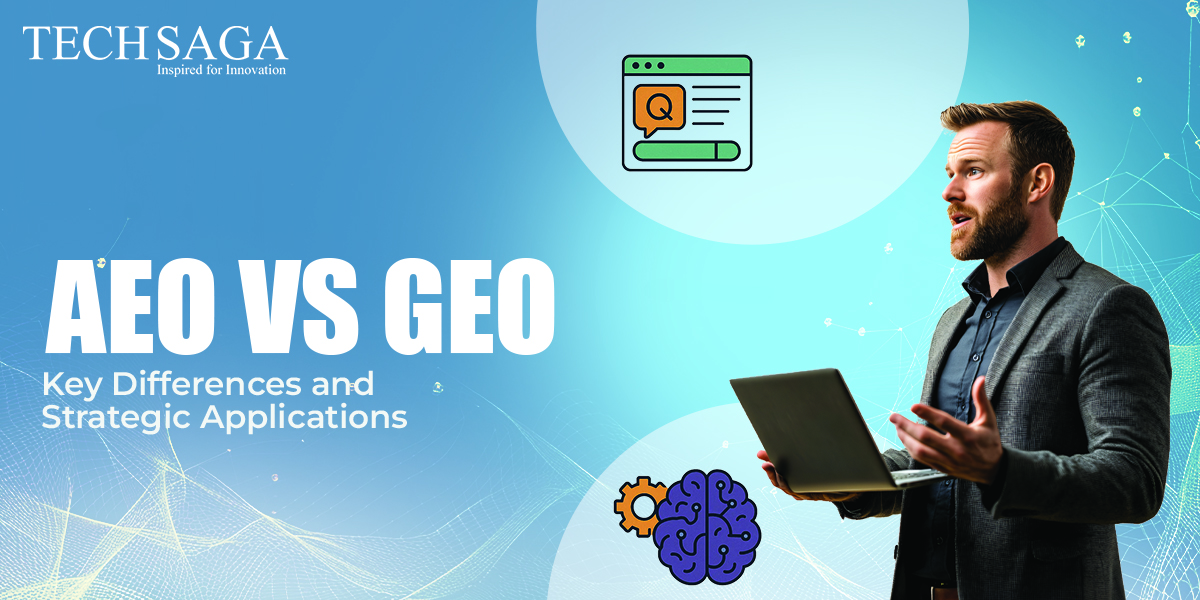Team Techsaga
Gain valuable insights and stay updated with the latest innovations through our engaging blog. Explore trends, technology advancements, and expert opinions to navigate the ever-evolving world of IT.
AEO vs GEO: Key Differences and Strategic Applications
In the era of digital marketing and search visibility, traditional SEO tactics are no longer enough. As search engines and AI-driven platforms continue to change how users access information, two emerging optimization strategies have gained prominence: Answer Engine Optimization (AEO) and Generative Engine Optimization (GEO).
Though both aim to improve online visibility, they differ in application, target platforms, and content strategies. Understanding their distinctions and synergies is vital for modern digital marketers who wish to future-proof their content strategy.
What is AEO (Answer Engine Optimization)?
Answer Engine Optimization is the process of optimizing your content specifically for answer engines, platforms designed to deliver direct answers to user questions. These include Google’s Featured Snippets, People Also Ask (PAA), Siri, Alexa, and other voice assistants.
Core Objectives of AEO:
- Provide precise, structured answers to user queries.
- Earn Featured Snippets and Zero-click results.
- Enhance voice search visibility.
- Align content with entities in Google’s Knowledge Graph.
Key Characteristics of AEO:
- Focuses on FAQ-style content.
- Highly structured, fact-based writing.
- Optimized for short, definitive answers.
- Structured data and schema markup are essential.
What is GEO (Generative Engine Optimization)?
Generative Engine Optimization involves optimizing content for AI-based generative systems like ChatGPT, Google’s SGE (Search Generative Experience), Perplexity AI, and Claude. These tools don’t just pull snippets; they create complete answers by combining information from multiple sources.
Core Objectives of GEO:
- Ensure your brand and content are referenced in AI-generated responses.
- Influence the training and indexing mechanisms of generative AI.
- Structure content for context-rich comprehension by LLMs.
Key Characteristics of GEO:
- Focuses on detailed, contextually rich content.
- Prioritizes E-E-A-T (Experience, Expertise, Authoritativeness, and Trustworthiness).
- Encourages unique, original content with brand perspective.
- Uses natural language that aligns with conversational AI models.
AEO vs GEO: Key Differences at a Glance
Here are some key differences between AEO and GEO.
1. Target Platforms
- AEO (Answer Engine Optimization)
-
- Targets platforms that provide direct answers to user queries.
- Common destinations include Google Featured Snippets, People Also Ask boxes, voice assistants like Siri and Alexa, and FAQ-rich snippets.
- The primary aim is to optimize for traditional search engines that display concise content above regular results.
- GEO (Generative Engine Optimization)
- Focuses on platforms powered by Large Language Models (LLMs) and Generative AI systems.
- Includes ChatGPT, Perplexity AI, Google Search Generative Experience (SGE), Claude, and similar AI-based engines.
- These platforms generate content dynamically based on user prompts, making citation and integration critical.
2. Primary Goal
- AEO
- To rank in zero-click results, where users find answers without visiting a webpage.
- Dominate quick-answer formats in SERPs and gain visibility in voice search results.
- Increase click-through rates (CTR) by positioning content at the top of search pages.
- GEO
- To ensure content is referenced or cited in AI-generated summaries, insights, or conversational responses.
- Emphasizes thought leadership, depth, and trust to appear in AI-generated citations.
- Drives brand authority in emerging AI-powered discovery environments.
3. Content Type
- AEO
- Demands concise, structured, and direct answers.
- Prioritizes bullet points, tables, numbered lists, and FAQ schemas for maximum visibility.
- Emphasize clarity and brevity to suit the short-form content requirements of voice assistants and snippets.
- GEO
- Encourages in-depth, context-rich, and insight-driven content.
- Conversational tone, explainer-style blogs, thought leadership articles, and detailed guides are most effective.
- Designed to educate and inform rather than just answer a query.
4. SEO Tactics
- AEO
- Relies on traditional SEO practices like:
- Schema Markup (e.g., FAQPage, HowTo, Breadcrumb)
- Answer paragraphs (40–50 words), lists, and keyword proximity
- HTML tag optimization for clarity
- Optimized for engines that scan structured data to extract answers.
- Relies on traditional SEO practices like:
- GEO
- Depends on semantic SEO, including:
- Entity recognition, latent semantic indexing (LSI)
- Internal linking for topic authority
- Brand tone consistency to signal credibility to LLMs
- Uses natural language and deep topic clusters to efficiently generate AI training data.
- Depends on semantic SEO, including:
5. Search Intent
- AEO
- Aligns with navigational and informational search intents.
- Targets users seeking quick facts, definitions, how-tos, or comparisons.
- Example: “What is an AEO certificate?”
- GEO
- Caters to exploratory, research-based, and multi-layered intents.
- Suits users asking broad, open-ended, or analytical questions.
- Example: “What are the long-term benefits of supply chain certification like AEO or GEO?”
6. Optimization Tools
- AEO
- Tools that assist with structured data and keyword optimization:
- Google Search Console, SEMrush, Ahrefs, Yoast SEO, Rank Math
- Schema.org markup generators
- Focus on tools that improve crawlability and indexing
- Tools that assist with structured data and keyword optimization:
- GEO
- Leverages advanced AI and NLP tools like:
- OpenAI embeddings, vector databases, semantic similarity tools
- Surfer SEO, MarketMuse, Frase, NeuronWriter for content depth
- Knowledge graphs and AI topic modeling for structured topical authority
- Leverages advanced AI and NLP tools like:
7. Key Benefit
- AEO
- Provides zero-click visibility, meaning your content gets exposure even without a site visit.
- Dominates the SERP real estate with featured snippets and voice responses.
- Builds brand trust by consistently appearing as the “go-to” answer in search and voice queries.
- GEO
- Increases your chances of being quoted, summarized, or paraphrased by LLMs.
- Drives brand recognition in AI-driven platforms where traditional SERP presence is limited.
- Positions your content within the new AI knowledge ecosystem
Strategic Applications of AEO
AEO is best suited for businesses looking to:
1. Dominate Voice Search of AEO
As smart assistants become part of daily life, clear and accurate content boosts the chances of being chosen as the top answer.
2. Win Google Snippets of AEO
Featured Snippets can dramatically improve CTR, especially for queries like “how to,” “what is,” or “best way to.”
3. Improve Local and Mobile SEO
Quick answers and FAQ content target mobile-first users and can boost engagement and reduce bounce rates.
4. Enhance Trust and Authority of AEO
Structured, precise answers help establish your site as a trusted knowledge source within your niche.
Strategic Applications of GEO
GEO is essential for brands aiming to remain visible in the era of AI-generated search. It’s ideal for:
1. Influencing AI Search Outputs of GEO
Generative engines use a wide pool of data; if your brand is mentioned consistently across authoritative sources, you increase your chances of citation.
2. Building Topical Authority of GEO
GEO encourages you to create deep content hubs that explore topics comprehensively, building brand equity over time.
3. Enhancing Thought Leadership of GEO
Long-form blogs, white papers, and expert commentary help your brand stand out in AI summarizations and recommendations.
4. Targeting Informational and Exploratory Intent of GEO
As users seek in-depth explanations from generative tools, your content must go beyond basic answers to deliver insight and value.
Integrating AEO and GEO: A Hybrid Strategy
While both AEO and GEO serve distinct roles, their integration offers maximum visibility across all search environments, both traditional and generative.
Here’s how to combine both:
- Start with structured content for AEO: Use schema, bullet points, headings, and FAQs.
- Expand content with in-depth analysis for GEO: Add expert quotes, research, examples, and narratives.
- Optimize for E-E-A-T: Ensure author bios, citations, and brand credibility are evident.
- Use NLP and Semantic SEO tools: Help generative engines “understand” your content context.
For example, a blog post on “How to Start a Dropshipping Business” can:
- Feature a 50-word summary in FAQ style (AEO).
- Offer a 1,200-word deep dive with expert insights and tools (GEO).
Final Thoughts
As search behavior changes, so must our optimization strategies. AEO addresses the needs of structured, quick-answer seekers and voice search users. GEO, on the other hand, emphasizes the growing importance of generative AI and its influence on user decisions through generated content. By strategically combining both methods, businesses can strengthen their presence across all search interfaces, from the top of a Google search results page to an AI assistant’s spoken response.
Ready to Optimize for the Future?
Whether you’re aiming to enhance your AEO visibility or future-proof your brand with GEO, staying ahead of the curve requires a tailored, dual-focus approach. Start creating intelligent, AI-friendly content today to capture tomorrow’s users, wherever they search.
TAG: Techsaga USA




